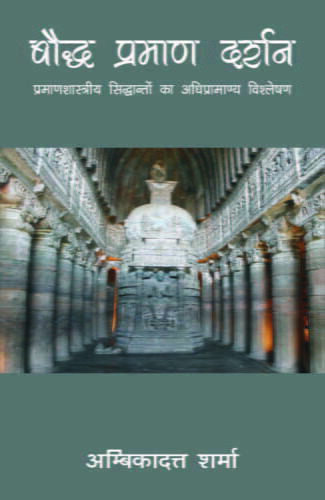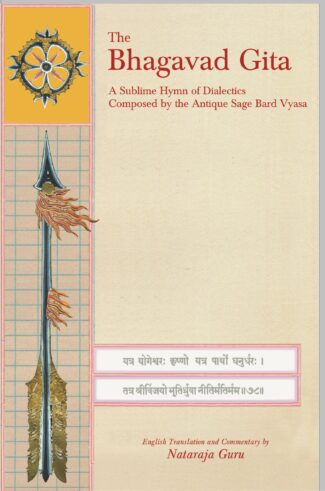Showing 81–90 of 1165 results
This book, published on the auspicious occasion of the rising of Atthi Varadar, contains a concise account of the Sthala-Puranam, the role of many Srivaishnava Acharyas. architecture, sculptures, inscriptions paintings, music, prasadam and festivals of the ancient and sacred temple of Varadaraja Perumal in Kanchipuram.

This book talks about the guruhood of Nataraja Guru, a true absolutist and a disciple of Narayana Guru, how he grafted it on to a global background, how his discoveries in philosophy open up a new age in human understanding, and his genius in restating yoga as a modern perennial science of dialectics applicable in all fields.
Nataraja Guru’s guruhood is pure and philosophically correct, making as few concessions as possible to relativistic or social notions. He is a guru of absolutist truth. It is too rare to be popularly understood. It is not the popular conception of the Upanishadic or the ashramic pattern. It is a new form of guruhood, made for a really global world. The Guru Narayana did the initial spadework here in breaking through the fixed Indian orthodox patterns, as far as he was able in his own lifetime to do so, without entirely destroying the background. His work was experimental, and his success showed the way to the one disciple, Natarajan, to plunge ahead on a wider and entirely universal scale. Nataraja Guru therefore has grafted guruhood on to a global background. For this work the absolutism of guruhood has to be stressed more than the religious or even the conventional yogi aspect as known to India.
Nataraja Guru never wanted a following, least of all of blind believers. He only asks for reasonable understanding of the pure principles for which he stands and not in any cloud-soaring sense either, but in immediately applicable relationship with any or every given actual situation; nor in works but in understanding alone.
His discoveries in the field of philosophy open up a new age in human understanding. Through his genius, for the first time clear sense emerges out of the hitherto baffling expressions of Indian thought, while the ways of Indian spirituality cease to be a mystery. So at one stroke minds are cleared and much delusion and superstitions trickery in the philosophic-religious field are destroyed. How bold and wonderful is his genius in restating yoga as a modern perennial science of dialectics applicable in all fields!

This book has something of value for lovers of both contemporary and traditional thinking on arts because of the diversity of its content Þ Aesthetics Today, The Quest for Key Aesthetic Concepts, Rasa Theory, Music and Silence, and Hindustani Rhythm an Aesthetic Theory and issue.
This book may well be expected to interest one and all, if only because of the diversity of its content and the way it has been presented.
It has something of value for lovers of both contemporary and traditional thinking on the arts. Essays on Aesthetics Today, The Quest for Key Aesthetic Concepts and The Aesthetic Attitude relate explicitly to present-day aesthetics; and the one on Rasa Theory may well be able to provide some new insights to those who are not averse to looking anew at this impressive foray of traditional Indian thinkers into the region of aesthetics.
However, the essay which is most likely to draw and hold readers attention because of the tantalizing appearance, so to say, of its very subject is the one on Music and Silence. Very few aestheticians have written on it so far; and nowhere, except in this book, is the reference all along to Hindustani music. Nor has our rhythm ever been written on in the way it appears in this book, in terms of the following essays: Hindustani Rhythm and Aesthetic Theory and Hindustani Rhythm and an Aesthetical Issue.
As for the essay on Attenboroughs classic film Gandhi, it may well make readers realize, in happy wonderment, how much they failed to mark when they saw it. Indeed, there is no reason why analytic writing on art should not make us ever more sensitive to the numberless creative devices it employs with delightful effect.

T.P. Verma and S.P. Gupta, after several years toil, have here presented the history of Ayodhaya in a chronological form from Rgveda times till today which has been proved with the evidences from archaeology, coinages, scriptures, etc.
T.P. Verma and S.P. Gupta, after several years toil, have here presented the history of Ayodhaya in a chronological form from Rgveda times till today which has been proved with the evidences from archaeology, coinages, scriptures, etc.

This book is a small attempt to express the love, affection and feelings towards children. Through pleasing illustrations, the authors have touched upon the various facets in the life of a child. Delightful verses add sweetness and charm to the book.
In the life of a human being the most sweet and memorable part is its childhood, say from its second year till its seventh or eighth. During this time the child is very innocent, full of life, playful, has no responsibility or worry, and when in fear or pain it calls its mother and she is there ever ready to protect it. It understands no restriction and has freedom to go and talk to anybody in the house. It does not know how to hate anyone — in fact, it is like the manifestation of the ever-gracious divinity in the world. A child is loved, respected and even adored.
This book is a small attempt to express the love, affection and feelings towards children. In Hindu pantheon the only divine family having children is that of Shiva and Parvati or Uma. Through pleasing illustrations, another made-for-each-other couple — the Kogatas — have touched upon the various facets in the life of the divine chidren — Ganesha and Karttikeya — together with their doting parents. The delightful verses add sweetness and charm to the book.

The work takes us on a journey through the famous Bagore-ki-Haveli, which typifies the best of Mewari architecture, to show us the splendour and magnificence of a Rajasthani royal household. With many colour photographs, it reconstructs the royal lifestyle and practices its customs, religious undertakings and costumes, and discusses the artistic beauty of the haveli.
Rajasthan boasts of many beautiful monuments and structures of the royalty which stand as evidence to Indias glorious ancient culture and heritage. The Bagore-ki-Haveli is one such edifice. The book takes us through the architectural wonders of the haveli to reflect what it had been the royal household of Maharaj of Bagore. With many splendid colour photographs of its impressive rooms, large balconies, wide terraces and attractive, leafy courtyards, it reconstructs the royal household and its functioning, customs and religious practices, costumes and ornaments, and arts and entertainment. It captures the artistic brilliance of the exquisite glass inlay work and paintings in the restored haveli including a gallery of Madhurastakam paintings describing the loveliness of Sri Krishna and his divine lover, Radha. The work highlights the charming style of the haveli that typifies the best of Mewari architecture but has a unique character of its own. The book, a visual delight presenting a glimpse into the royal lifestyle and splendour of the time, will be invaluable to historians studying the history, art and architecture of north India in the centuries before Indias independence and will also interest readers in general as well as tourists.

Making the basic doctrines of Buddhist epistemology the fundamental point of reference, this treatise attempts have been made to demonstrate that how Indian epistemological intellection/thinking keeps metaphysics in itself as a bequest, and in its expanding/enlarging form it persistently expresses the metaphysical divisions.
In Indian tradition of knowledge, the historical advancement of epistemological intellection/thinking flourished through five alternative points of departure, where the first belongs to Maharshi Gautama, who showing priority of epistemology over metaphysics, proposes a constructive model of epistemology. In opposition to this universally acceptable postulation of Maharshi Gautama, three refutative points of departure of epistemological critique of Nagarjuna, Sri Harsha and Jayarasi Bhatta progressed. These three attain their cognitive termination either in the severance of the priority and the position of episteme or in the deconstruction of epistemology. The fifth point of departure evolves from Tarka Pungava Dinnaga, which, parallel to Gautamas exposition and as an option of substitution to Nagarjunas epistemic displacement, presents a reconstructive model of metaphysical epistemology.
In this treatise, an effort has been made to understand the foundational structure of the aforementioned Bauddha Prasthan through certain basic principles, which happen to be the deciding factors/determinative agents in respect of dissensions relating to the matter and corollary, features, and a number of episteme and alternative approaches. From the espoused system of analysis and explication for the purpose, the meta-epistemic dimension of epistemological intellection/thinking of Indian philosophy gets revealed. In fact, it is in this dimension, the optional feature of epistemological doctrines can be recognized to know further that why any epistemological assessment/appraisal is like this?, why isnt it different? In this way, making the basic doctrines of Buddhist epistemology the fundamental point of reference, this treatise attempts have been made to demonstrate that how Indian epistemological intellection/thinking keeps metaphysics in itself as a bequest, and in its expanding/enlarging form it persistently expresses the metaphysical divisions.

This book delves into the contribution of feminist thinkers to examine their transformation of the activity of philosophy itself in the course of its contact with the feminine. Feminist philosophy brings about a greater awareness of philosophy’s relation to history, culture and other disciplines. There exists a struggle between femininity and feminism in the philosophical corpus of feminist thinkers with reference to the concept of care.
This book engages with the contribution of feminist thinkers to examine their transformation of the activity of philosophy itself in the course of its contact with the feminine. It also portrays how the feminist philosophy brings about a greater awareness of philosophy’s relation to history, culture and other disciplines. The author vividly puts into limelight the struggle between femininity and feminism in the philosophical corpus of feminist thinkers with reference to the concept of care. She takes pioneering feminism during the colonial period as its starting point and moves to its second wave during the post-colonial period to examine the trajectory of the concept of care.
Women do not form a homogeneous category. Therefore, this volume explores the extent to which Ramabai, Wollstonecraft, Okin, Gilligan and de Beauvoir can dialogue with the contemporary women. The relationship between these thinkers and their arguments is conceptually connected. The book addresses a few questions such as what is femininity, can one define feminine at all, how does a feminist feminine differ from a patriarchal feminine, can male philosophical frameworks be employed in feminist directions, among others.
The book also investigates the shifts from the colonial to post-colonial periods in the feminist approaches to care. It examines the possibility of integrating feminine care with the political concepts of justice and autonomy. An added task of intervening in the conceptual categories of Western feminism in an attempt to blur the strict binary between the Indian and Western traditions, is also explored.

Standing tall in the field of Bhagavad Gita commentaries, this book is the result of the revolutionary treatment given by Nataraja Guru to this ancient masterwork of the human race to be appreciated as a universally applicable psychology of life and living.
Nearing its fiftieth year of being continuously in print, Nataraja Gurus monumental analysis of one of the greatest philosophical classics of Planet Earth is now available in a new edition. Generations have benefited from its unique angle of vision, which introduces a universal framework that does not depend on faith to impart its message of infinite potential for every human being. The Gurus wry humor, fresh insights, and fearless challenges to prevailing orthodoxies, are clear marks of his style. His analysis is radical by any measure, yet it must be noted that much of the scientific and philosophic community has evolved over the same half century toward a similar global, broad-minded outlook to the one which the Guru brings to bear in these pages, and which not coincidentally is advocated by the Bhagavad Gita itself.
| There are no products |